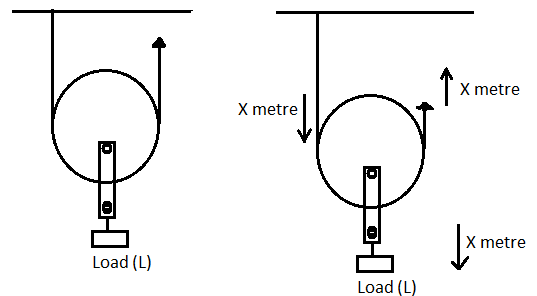
What is the velocity ratio of a single movable pulley?
A. 1
B. 0.5
C. 2
D. 1.5
Answer
519.9k+ views
1 likes
- Hint:- The ratio of the distance moved by the effort force applied to the object and the distance moved by the object load under is known as the Velocity ratio of any body.
Formula Used :- Velocity ratio =
Complete step-by-step solution -
Let us first, draw the diagram for the single movable pulley.
Now let the load L be attached to the single movable pulley.
So, the rope must be fixed at a point in the ceiling such that it passes through the movable pulley.
Now if we had to lift the load L attached to the pulley by distance X metres. We had to apply the effort F to travel a distance of 2X metres. Effort had to travel the 2 times the distance because X metre travelled to the effort rope of one side of the pulley and another X metre travelled to the effort rope of another side of the pulley.
But the distance travelled by the load will be only X metre.

Now as we know that velocity ratio is defined as the ratio of distance travelled by the effort to the distance travelled by the load.
So, velocity ratio of the single moveable pulley will be =
As the velocity ratio is ratio. So, it will be unitless.
Hence, the correct option will be C.
Note:- Whenever we come up with this type of problem we should remember that when a load is lifted down by some distance then the force by which it is lifted must be applied for the double distance because when any object attached with pulley is lifted then force is applied on the ropes on different side of the pulley because one side rope move upward and other side rope moves downward by the same distance.
Formula Used :- Velocity ratio =
Complete step-by-step solution -
Let us first, draw the diagram for the single movable pulley.
Now let the load L be attached to the single movable pulley.
So, the rope must be fixed at a point in the ceiling such that it passes through the movable pulley.
Now if we had to lift the load L attached to the pulley by distance X metres. We had to apply the effort F to travel a distance of 2X metres. Effort had to travel the 2 times the distance because X metre travelled to the effort rope of one side of the pulley and another X metre travelled to the effort rope of another side of the pulley.
But the distance travelled by the load will be only X metre.

Now as we know that velocity ratio is defined as the ratio of distance travelled by the effort to the distance travelled by the load.
So, velocity ratio of the single moveable pulley will be =
As the velocity ratio is ratio. So, it will be unitless.
Hence, the correct option will be C.
Note:- Whenever we come up with this type of problem we should remember that when a load is lifted down by some distance then the force by which it is lifted must be applied for the double distance because when any object attached with pulley is lifted then force is applied on the ropes on different side of the pulley because one side rope move upward and other side rope moves downward by the same distance.
Latest Vedantu courses for you
Grade 7 | CBSE | SCHOOL | English
Vedantu 7 CBSE Pro Course - (2025-26)
School Full course for CBSE students
₹45,300 per year
Recently Updated Pages
Master Class 9 General Knowledge: Engaging Questions & Answers for Success

Master Class 9 English: Engaging Questions & Answers for Success

Master Class 9 Science: Engaging Questions & Answers for Success

Master Class 9 Social Science: Engaging Questions & Answers for Success

Master Class 9 Maths: Engaging Questions & Answers for Success

Class 9 Question and Answer - Your Ultimate Solutions Guide

Trending doubts
State and prove Bernoullis theorem class 11 physics CBSE

What are Quantum numbers Explain the quantum number class 11 chemistry CBSE

Who built the Grand Trunk Road AChandragupta Maurya class 11 social science CBSE

1 ton equals to A 100 kg B 1000 kg C 10 kg D 10000 class 11 physics CBSE

State the laws of reflection of light

One Metric ton is equal to kg A 10000 B 1000 C 100 class 11 physics CBSE




